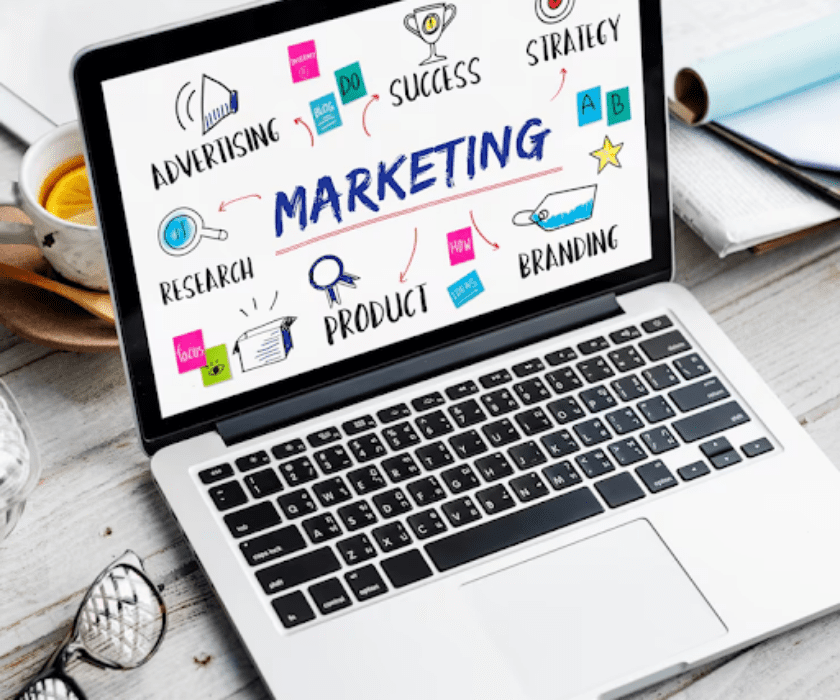Digital sales funnels lead your prospects along an increasingly engaged journey—increasing interest and curiosity and bringing people to the point of action. They’re more effective at streamlining the buying journey, providing actionable paths from discovery to sale.
When executed with the proper format, they assist businesses in achieving the proper audience, enhancing engagement, and increasing conversion charges. From email drip campaigns to personalized landing pages, every stage is designed to build trust and provide value.
These funnels are the most powerful business tools that every business can use for more profitable and predictable online sales.
What Are Digital Sales Funnels
A digital sales funnel helps your future customers take the next step in a straightforward, easy-to-understand way. It turns interested prospects into paying customers at every stage. This pathway creates a more streamlined customer journey.
Every step is intentional, establishing credibility, igniting curiosity, and urging conversion with each encounter. By meeting personal preferences at each step, digital sales funnels provide a more enriching customer journey experience and optimize conversions along the way.
1. Definition of Digital Sales Funnels
Each of a digital sales funnel’s many stages plays a different role. At the top, prospects start to learn about a company’s product or service. Then, you take them further down the funnel to express interest by deeper engagement.
The decision stage allows them to compare choices, and action pushes them to make the purchase. Terms such as “lead magnet,” “amplifier,” and “conversion event” define every stage of this funnel. They all play their part to ensure that you have a smooth transition from the top of the funnel to the bottom.
2. Importance in Online Marketing
Digital sales funnels are the lifeblood of your organization’s ability to generate the most revenue and keep customers coming back. Providing free consultations, eBooks, or webinars is a typical practice within funnels to demonstrate knowledge and build trust.
With tools such as competitor analysis and SMART goals, businesses are able to craft targeted strategies that hone in on the most effective efforts. Considering how 80% of sales usually result from only 20% of efforts, detailed strategic planning maximizes both time and outcome.
3. Difference Between Sales and Marketing Funnels
While sales funnels are primarily designed to close deals, marketing funnels are designed to create leads. Together, they form a powerful strategy.
For example, sales funnel KPIs may measure conversion events, while marketing funnels measure lead generation and engagement. Both are equally important and work in tandem, creating a smooth flow from awareness to purchase.
Key Components of a Digital Sales Funnel
A digital sales funnel describes the path a prospect takes. It leads them from learning about your brand to converting them into a repeat customer. It’s divided into three stages: Awareness, Consideration, and Conversion. Each stage needs targeted tactics to move prospects smoothly through the buying journey.
By combining key components effectively, businesses can not only attract leads but nurture and convert them into long-term customers.
Awareness and Lead Attraction
Blog posts, videos, and infographics that solve common problems are essential in this stage. Platforms like Facebook or Instagram can be utilized for targeted ads. SEO plays a crucial role with optimized webpages to rank higher in search results.
Strong messaging captures attention by addressing pain points directly. A visitor’s journey usually begins here, and you know what they say about first impressions. Social proof, such as testimonials, and frequently asked questions build trust right from the start.
Interest and Engagement Strategies
Interactive content, like polls or quizzes, helps to keep prospects engaged. Email campaigns are one of the best tools to nurture that interest, delivering personalized offers or project updates to keep them engaged.
Reviews and testimonials provide social proof, further establishing credibility.
Evaluation and Building Trust
Offering detailed case studies and hosting live Q&A sessions help establish credibility and trust. By sharing valuable solutions to common problems, businesses provide true value.
Webinars deepen engagement and position your brand as an expert.
Decision and Conversion Tactics
Build some urgency into the funnel with limited-time offers and discounts. Feature comparisons make the decision easy, and incentives such as no-obligation bonuses spur decision making.
Social proof is still a powerful motivator in making that final decision.
Action and Retention Techniques
A fast, frictionless checkout process is essential for minimizing cart abandonment. Follow-up emails after a purchase help your customers remain happy with their purchase and lead to more repeat sales.
Loyalty programs incentivize repeat purchases and increase customer lifetime value.
Stages of a Digital Sales Funnel
Your digital sales funnel should map out the path your prospects follow from learning about your brand to becoming repeat customers. Each stage requires different approaches to nurture your audience at every step of the way, leading them to conversion and keeping them engaged over time.
By having a solid grasp of these stages, businesses can better hone their efforts and truly address the needs of their audience at every stage.
1. Awareness Stage
This is the stage where potential customers are first introduced to your business. Building awareness involves:
- Using SEO to improve visibility in search engine results.
- Running social media campaigns to reach target demographics.
- Or putting more budget into paid ads, including Instagram Ads; these ads improve success rates by 74%!
By developing interesting, authentic content, you can help your audience think of your brand first. Metrics such as impressions, website traffic, and digital ad engagement indicate success and can be used to optimize strategies.
For instance, Ringle pulls in leads from organic searches, demonstrating the importance of having SEO-optimized content.
2. Interest Stage
Effective tactics include:
- Publishing blogs, videos, or emails tailored to their interests.
- Providing lead magnets such as free trials or eBooks in exchange for their contact information.
Monitoring engagement metrics, such as email open and click-through rates, can show you what strategies are working or not working best. Personalizing the email sequence or hosting your own live workshops can help drive even more interest, particularly in sectors like ed-tech or e-commerce.
3. Decision Stage
Businesses can:
- Provide detailed comparisons and product insights to address concerns.
- Share customer testimonials or case studies to establish trust.
- Deploy retargeting ads reminding users about previously viewed products.
For example, being able to send targeted emails to distinct audiences lets businesses test which approaches get the most response. Focusing on benefits, not features, can help move those still on the fence toward making a decision.
4. Action Stage
The focus shifts to facilitating purchases. Strategies include:
- Simplifying the checkout process for seamless transactions.
- Using obvious CTAs, like “Buy Now,” to move prospects along.
Keeping an eye on conversion rates brings to light areas in need of improvement. For B2C businesses, social proof is important, as reviews and testimonials help reinforce their confidence, putting the consumer’s interests ahead of the product’s features.
Highlighting customer success stories is a great way to inspire people to buy.
5. Post-Purchase Stage
Maintaining engagement post-sale strengthens relationships. Effective strategies include:
- Sending thank-you emails and requesting feedback.
- Encouraging customers to share their experiences on social platforms.
Analyzing what customers do once they purchase helps you create better campaigns moving forward. Retention efforts, such as exclusive content or loyalty programs, create advocacy, ensuring continued interest and repeat purchases.
How to Build an Effective Sales Funnel
Designing an effective digital sales funnel takes careful planning, a deep understanding of customer needs, and continuous optimization. A well-designed funnel guides potential customers through the stages of awareness, interest, and decision/action, ensuring they don’t drop off before making a purchase.
Not every lead will turn into a paying customer, but the objective is to convert as many as possible by meeting potential customers’ needs at every stage. We’ve outlined the process below to give you some actionable steps to get started.
Understand Your Target Audience
To build an effective funnel, begin by knowing what audience you’re trying to reach. Do your market research to figure out your ideal customers’ preferences, problems, and goals.
From there, create deep buyer personas that reflect demographic, behavioral and emotional data. An eCommerce nutrition brand, for example, may want to develop personas around their busy parents looking for healthy meal solutions.
Then take these insights to create content and campaigns that meet them where they are. Relevant, personalized messaging goes a long way when it comes to engagement.
Create a Compelling Offer
A killer offer is the bedrock of your funnel. Explain the value your product provides, not just the features it has.
Let’s say you’re a skincare brand—focus on the fact that your product clears up blemishes and improves self-esteem. Create your unique selling propositions (USPs).
Your USPs should make you stand out from the crowd. Test various offers—discounts, premium bundles, etc.—to find out what your audience responds to best.
This ongoing process will help your funnel continually attract and convert leads more effectively.
Design a High-Converting Landing Page
Your landing page is the last stop before a visitor makes the decision to take the next step. It should include strong CTAs, persuasive copy, and few distractions.
A fitness subscription service can use visuals to tell the story of real customer transformations. Or perhaps they would motivate future users with a CTA that reads, “Start Your Free Trial Today!
A/B testing various headlines or layouts through your funnel will help you discover what resonates most with your audience. Keep in mind that even minor adjustments can lead to major increases in conversion rates.
Develop an Email Nurturing Campaign
Email campaigns help convert that new interest into a purchase. Develop a sequence of emails that can be customized to different stages of the funnel.
For example, an e-commerce brand could send an introductory email sharing the brand story, followed by product recommendations based on browsing history. Make it personal.
Personalization is the key—leverage first- and zero-party customer data to create highly relevant content. Monitor metrics such as open and click-through rates to continuously improve your strategy.
Use Analytics to Improve Performance
Data is incredibly important for optimizing funnels. Monitor important KPIs such as conversion rates, bounce rates, and average order value.
Tools such as Google Analytics are instrumental in identifying where users are dropping off in the funnel. For example, if a large percentage drops off your cart page, try providing a discount code through retargeting ads.
Reviewing and acting on analytics regularly will help you remain as an efficient, agile, and effective machine.
Strategies for Optimizing Digital Sales Funnels
The trick to successfully optimizing a digital sales funnel is leveraging smart strategies to boost funnel performance, enhance customer experience, and drive higher conversion rates. By prioritizing personalization, automation, testing, and mobile usability, businesses can develop smooth and successful funnels.
Further down, we’ll outline these actionable strategies with real-world examples to inspire your own funnel optimization.
Personalize Content for Your Audience
Segmentation gives you the power to speak directly to different segments of your audience. For example, if you send new account creation emails to new visitors and returning customers, you risk sending irrelevant content to both groups.
Dynamic content such as personalized product recommendations or location-based offers improve engagement on both sites and emails. Monitor performance metrics such as click-through rate (CTR) and time on page.
These metrics can show you which pieces of targeted content are actually resonating with your audience. Tools like HubSpot or Mailchimp can easily guide you through the process of developing these strategies.
Leverage Automation Tools Effectively
Marketing automation tools make easy work of repetitive tasks. Automated email sequences like welcome emails or abandoned cart reminders both nurture leads and save you time.
Using platforms like ActiveCampaign or Drip, e-commerce businesses can monitor automation performance and make sure everything is in line with their objectives. It’s as simple as creating a post-purchase email to cross-sell relevant items.
Test and Refine Funnel Elements
That’s why A/B testing is important to determine what resonates best. Testing two versions of a landing page, for example, can help determine which landing page design leads to more sign-ups.
Tools like heatmaps and session recordings help you see how users navigate through your site, where they click, and where they’re getting lost. Small, iterative changes—such as adjusting headlines or changing call-to-action (CTA) buttons—will make the funnel work better over time.
Focus on Mobile-Friendly Experiences
Given that mobile users now represent more than half of all online traffic, optimizing for mobile is no longer optional. It’s crucial to make sure these pages load quickly and are easy to navigate on smaller screens.
Test checkout flows on mobile frequently to catch usability issues before they affect customers. Tracking mobile conversion rates can help you identify where improvements are most needed.
Simplify the Customer Journey
A tight digital sales funnel reduces friction. Cutting out pointless hurdles, like too many form fields, helps users feel confident that they can get through a purchase.
Providing clear direction, such as a visual progress bar throughout the checkout process, helps customers know what to expect. Engaging with customer feedback will help identify points of friction and moments of opportunity in order to create a more seamless journey.
Role of Content in Digital Funnels
Content fuels digital sales funnels, nurturing prospects through each step of their journey. It carries them along your digital funnel from awareness to action and back again. It keeps your audience engaged, sure, but more importantly, it helps you meet their individual needs at each touchpoint along the way.
A solid content strategy doesn’t stop at generating new leads; it helps nurture those leads until they convert into loyal customers.
Attracting Leads with Quality Content
Creating high-value content focused on the needs and interests of your audience is key to maximizing your visibility potential. Blog posts, videos, or infographics that clearly answer the question or solve the problem are your best tools.
Leveraging SEO ensures your content ranks well on search engines, capturing some of the 75,000 searches per second on Google. In the background, social media and email campaigns further expand your reach, funneling potential supporters into your digital funnel.
Educating Prospects with Informative Resources
Educational resources such as eBooks, webinars, or how-to guides further establish your credibility and build trust. With an emotional layer, storytelling makes content stand out.
Tools such as Google Analytics can help you track engagement to continuously fine tune your strategy.
Converting Leads Through Persuasive Copy
Persuasive language emphasizing top benefits make it clear leads should take the next step. Strong CTAs such as “Get Started Today” along with A/B testing helps to maximize conversion rates.
Go beyond assumptions to align messaging with customer data to drive better results.
Types of Digital Marketing Funnels
Digital marketing funnels are intentional, step-by-step journeys created to lead prospective customers through the purchase decision. They serve unique stages of the customer journey, from awareness, to consideration, conversion and loyalty.
Selecting the most effective funnel type for your objectives not only creates a smoother experience for users, but fuels better, more measurable results.
Lead Generation Funnels
Lead generation funnels are used primarily to attract, capture, and collect leads. Effective tactics include:
- Using lead magnets like free eBooks or discounts.
- Creating landing pages with clear, persuasive messaging.
- Running targeted ad campaigns on social media platforms.
Great offers and high-value content are key to lead generation. By keeping a close eye on metrics like lead quality and conversion rate, you can continuously optimize your strategies to achieve better results.
Webinar Funnels
Webinars are the best type of digital marketing funnel when it comes to engagement and conversions. Considerations involve planning content of value, promotion of the event and post-event follow-up sequence.
Monitor attendance and post-webinar conversions to get a full picture of success.
Product Launch Funnels
High-impact product launches need strategies such as influencer partnerships, countdown campaigns, and pre-launch pre-orders.
Pre-launch marketing creates a buzz, and post-launch evaluation ensures that every campaign can be better than the last.
Ecommerce Funnels
Ecommerce funnels focus on driving sales first and foremost, designing product pages and checkout flows with these leads in mind.
Keeping an eye on your cart abandonment rates and other key metrics will help you iterate and improve over time.
Lead Conversion Techniques
A carefully crafted sales funnel takes your leads on a journey and helps them transform their interest into action. Converting leads into customers isn’t magic — it’s the result of techniques that nurture their needs, establish trust, and motivate faster decisions.
Keep reading, as we dive into the top techniques that enhance lead conversions and relationship-building.
Use Scarcity and Urgency Tactics
Scarcity tactics, such as low-in-stock alerts, foster a fear of missing out and a perception of exclusivity that encourages immediate action. For example, displaying “Only 3 items left!” on a product page encourages immediate action.
Similarly, urgency tactics, like countdown timers for sales, increase the sense of urgency to act quickly. Monitoring conversion data helps identify the impact of these strategies, ensuring they resonate with your audience.
Offer Social Proof and Testimonials
Customer testimonials and case studies are powerful tools to show real-world satisfaction and build trust. Finally, social proof—including user-generated content or reviews—significantly increases credibility and trustworthiness—which is especially important in B2C markets.
For example, platforms like Ringle, which is geared toward appealing to international students, feature customer success stories to build rapport with potential customers. Ongoing analysis keeps these strategies working for you.
Provide Clear Calls-to-Action
An effective CTA is bold, clear, and easy to find, leading users to the next step effortlessly. Experiment with different placements—such as a button at the top of a page vs bottom—and adjust the language accordingly.
For example, using “Get Exclusive Access” instead of “Learn More” will get you more clicks. By continually monitoring performance, you can help make sure your CTAs are always having the biggest impact.
From Clicks to Conversions
In a digital marketing sales funnel, the journey from awareness to conversion requires a lot more strategy and precision. Each funnel stage has a specific goal that guides users like an escalator from initiation all the way to conversion. Businesses aiming to optimize their digital marketing strategy must focus on driving targeted traffic, maintaining relevance, and simplifying the path to purchase.
Optimize Ad Campaigns for Traffic
The foundation of the most effective ad campaigns is reaching the right people with the right message. Tools like Facebook Ads and Google Ads give businesses the power to specifically reach the demographics, interests, and behaviors they want to target. That emphasis means ads target the audience most likely to convert.
For example, a niche e-commerce clothing retailer catering to young professionals may want to target age, income level, and urban areas. Tracking ad performance metrics such as CTR and conversion rate offers important information. If an ad promoting discounted running shoes shows a high CTR but low conversions, revisiting the landing page or messaging might be necessary.
Bump up your ad spend on the best performers to make sure your money is going to the right places. This strategy is the best way to maximize your ROI.
Align Landing Pages with Ad Messaging
Landing pages are the final connection between your ad and the conversion you want people to take. Ensure ad messaging matches the landing page content. Creating consistency between ad messaging and the landing page content promotes trust with users and reinforces engagement.
So, if you headline your ad with “50% off on sustainable cookware,” your landing page should feature that offer front and center. Branding elements, including logos, fonts, and color schemes should all be the same across your ads and landing pages to create a sense of familiarity.
Testing different formats of headlines or call-to-action button locations on landing pages should be a regular practice to see what’s the best performing variation to use. When it comes to understanding what really hits home with your audience, A/B testing tools can help you find out. This ensures that each click turns into a valuable engagement.
Streamline Checkout Processes
A fast and easy checkout experience can significantly impact the success of your digital marketing sales funnel. Eliminating unnecessary steps, such as allowing guest checkouts and reducing form fields, minimizes friction in the purchasing process. By providing convenient payment methods, including GCash, PayMaya, and Debit/Credit cards, you empower your customers to choose their preferred payment options.
Tracking cart abandonment rates and other key metrics is essential for refining your marketing strategy. If users frequently leave at the shipping page, consider improving clarity on delivery times or offering cheaper shipping to encourage them to proceed.
For example, Lazada effectively utilizes urgency during sale events with countdowns and flash sales, which can be a great sales funnel strategy to motivate consumers to make quicker purchasing decisions.
Conclusion
Digital sales funnels allow you to nurture prospects down the path to a purchase, leading them to thoughtful decisions. They simplify the journey into distinct stages, helping you reach your audience at the right time with the right message. With a dedication to compelling content, strategic thinking, and user-friendly design, you’ll convert curious leads into lifelong customers. Each step in the funnel is important, from the initial click to the completed purchase.
Don’t rush—really take the time to learn about your audience and fine-tune the process. Even minor adjustments can have a significant impact on performance. Don’t make digital sales funnels an afterthought. Sales is great, but a tactically constructed funnel does more than increase revenue—it establishes credibility and fosters lifelong customer loyalty.
Ready to optimize your sales funnel? Let Web Design Davao help you design a personalized strategy that drives results. Contact Us today and let’s get started on transforming your digital sales approach!




